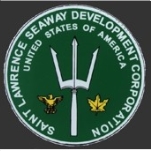industry’s environmental footprint in the waterway, by addressing several specific issues, including aquatic invasive species, cargo residues, greenhouse gases, pollutant air emissions, and oily water.
Transiting the Seaway - What You Need to Know
|
B-S Industrial Contractors, Inc.
|
$2,106,889
|
|
Kovilic Construction Company, Inc.
|
$1,100,000
|
|
Murnane Building Contractors, Inc.
|
$998,820
|
|
Fluid Power Service Corp.
|
$578,955
|
|
J. E. Sheehan Contracting Corp.
|
$351,000
|
|
Bouygues
|
$342,045
|
|
Government of the United States
|
$339,659
|
|
Blue Cross and Blue Shield of Central New York, Inc.
|
$265,500
|
|
Carter’s Trucking and Blacktopping, Inc.
|
$255,225
|
|
Village of Clayton
|
$229,300
|
- Table of Contents
- Overview
- History
- What it Does
- Where Does the Money Go
- Controversies
- Suggested Reforms
- Comments
- Leave a comment


On July 24, 2013, the White House announced that Betty Sutton would be appointed administrator of the Saint Lawrence Seaway Development Corporation, a government-owned corporation that operates and maintains the U.S. portion of the St. Lawrence Seaway. A system of locks, canals and channels stretching along the St. Lawrence River between Montréal and Lake Erie, the Seaway allows ocean-going vessels to travel between the Atlantic Ocean and the Great Lakes.
Born July 31, 1963, and raised in the Akron, Ohio, suburb of Barberton, Betty Sutton was the daughter of a factory worker and a clerk. She attended public schools and earned a B.A. in political science at Kent State University in 1985, and a law degree at the University of Akron School of Law in 1990.
Sutton commenced her political career during her first year of law school, running for and winning an at-large seat on the Barberton City Council in 1990. A year later, she was appointed to an at-large seat on the Summit County Council and served until 1992, including service as the council’s elected vice president. That same year, at age 29, Sutton became the youngest woman ever to win election to the Ohio House of Representatives, where she served for eight years until term limits forced her to resign in 2000.
Leaving public service, Sutton worked as a labor lawyer with the Cleveland firm of Faulkner, Muskovitz & Phillips from 2001 to 2006, where she worked closely with the International Longshoremen’s Association (ILA), the union that represents dock workers throughout the Great Lakes and the Seaway.
In 2006, sensing a political opportunity in the decision of Rep. Sherrod Brown (D) to vacate his seat in the U.S. House of Representatives in order to run for Senate, Sutton ran for and won his seat representing Ohio’s 13th congressional district. Sutton won re-election in 2008 and survived the Republican wave in 2010, but redistricting forced her into a more Republican district where she lost re-election in 2012.
While in the House, Sutton was recognized as a “key House architect” of the American Clean Energy and Security Act that passed the House in June 2009, primarily for her role in offering an amendment that established the popular “Cash for Clunkers” program that helped the U.S. auto industry weather the worst months of the Great Recession.
Sutton’s appointment was greeted positively by Seaway stakeholders. “We could not be more pleased with Sutton’s appointment as Seaway Administrator,” said Donald N. Cree, President of Great Lakes Maritime Task Force (GLMTF), a labor/management coalition that promotes waterborne commerce on the Great Lakes and the Seaway.
Labor chimed in as well. “With Sutton at the Seaway’s helm, we can be assured that the overriding goal of every action taken will be to create and sustain jobs for American workers and opportunities for American companies,” said John D. Baker, 2nd Vice President of GLMTF and President Emeritus of the ILA’s Great Lakes District Council. “The Seaway could not be in better hands.”
Sutton currently resides in Copley Township, Ohio, with her husband, Doug Corwon, a mediator with the Federal Mediation and Conciliation Service.
-Matt Bewig
To Learn More:
Biography (Wikipedia)
Betty Sutton, Former Congresswoman to be Appointed to Head Saint Lawrence Seaway Agency (Cleveland Plain Dealer Staff)
Lakes Welcome Sutton Appointment as Seaway Administrator (Great Lakes Maritime Task Force press release)

Collister “Terry” Johnson earned a B.A. in American Studies from Yale, where he was one of George W. Bush’s roommates. He went on to earn a J.D. from the University of Virginia, in Charlottesville. Johnson began his career as a lawyer, including serving as an Assistant County Attorney in Fairfax County, Virginia; a Deputy Public Counsel of the U.S. Rail Services Planning Office. He was an associate partner at the Washington D.C. law firm of Peabody, Rivlin, Lambert & Meyers, and a partner at Lockie & Johnson, also in D.C. Johnson was also a Senior Vice President at WFS Financial Corporation; Chairman of the Virginia Port Authority; President and CEO of FastShip Atlantic; a Senior Consultant at Mercer Management; and a member of the Board of Directors of the Overseas Private Investment Corporation, a position to which he was appointed by President George W. Bush.
- Latest News
- D.C. Public Schools will Teach all Second-Graders to Ride a Bike
- New Rule in Germany Limits Sales of Sex-Themed E-Books to 10pm to 6am
- What Happened to the 6-Year-Old Tibetan Boy the Chinese Government Kidnapped 20 Years Ago?
- U.S. Ambassador to Turkey Photoshops his Hair Color to Mock Turkish Mayor
- Mystery Artist Calls Attention to Unfixed Potholes by Drawing Penises around Them
industry’s environmental footprint in the waterway, by addressing several specific issues, including aquatic invasive species, cargo residues, greenhouse gases, pollutant air emissions, and oily water.
Transiting the Seaway - What You Need to Know
|
B-S Industrial Contractors, Inc.
|
$2,106,889
|
|
Kovilic Construction Company, Inc.
|
$1,100,000
|
|
Murnane Building Contractors, Inc.
|
$998,820
|
|
Fluid Power Service Corp.
|
$578,955
|
|
J. E. Sheehan Contracting Corp.
|
$351,000
|
|
Bouygues
|
$342,045
|
|
Government of the United States
|
$339,659
|
|
Blue Cross and Blue Shield of Central New York, Inc.
|
$265,500
|
|
Carter’s Trucking and Blacktopping, Inc.
|
$255,225
|
|
Village of Clayton
|
$229,300
|
Comments


On July 24, 2013, the White House announced that Betty Sutton would be appointed administrator of the Saint Lawrence Seaway Development Corporation, a government-owned corporation that operates and maintains the U.S. portion of the St. Lawrence Seaway. A system of locks, canals and channels stretching along the St. Lawrence River between Montréal and Lake Erie, the Seaway allows ocean-going vessels to travel between the Atlantic Ocean and the Great Lakes.
Born July 31, 1963, and raised in the Akron, Ohio, suburb of Barberton, Betty Sutton was the daughter of a factory worker and a clerk. She attended public schools and earned a B.A. in political science at Kent State University in 1985, and a law degree at the University of Akron School of Law in 1990.
Sutton commenced her political career during her first year of law school, running for and winning an at-large seat on the Barberton City Council in 1990. A year later, she was appointed to an at-large seat on the Summit County Council and served until 1992, including service as the council’s elected vice president. That same year, at age 29, Sutton became the youngest woman ever to win election to the Ohio House of Representatives, where she served for eight years until term limits forced her to resign in 2000.
Leaving public service, Sutton worked as a labor lawyer with the Cleveland firm of Faulkner, Muskovitz & Phillips from 2001 to 2006, where she worked closely with the International Longshoremen’s Association (ILA), the union that represents dock workers throughout the Great Lakes and the Seaway.
In 2006, sensing a political opportunity in the decision of Rep. Sherrod Brown (D) to vacate his seat in the U.S. House of Representatives in order to run for Senate, Sutton ran for and won his seat representing Ohio’s 13th congressional district. Sutton won re-election in 2008 and survived the Republican wave in 2010, but redistricting forced her into a more Republican district where she lost re-election in 2012.
While in the House, Sutton was recognized as a “key House architect” of the American Clean Energy and Security Act that passed the House in June 2009, primarily for her role in offering an amendment that established the popular “Cash for Clunkers” program that helped the U.S. auto industry weather the worst months of the Great Recession.
Sutton’s appointment was greeted positively by Seaway stakeholders. “We could not be more pleased with Sutton’s appointment as Seaway Administrator,” said Donald N. Cree, President of Great Lakes Maritime Task Force (GLMTF), a labor/management coalition that promotes waterborne commerce on the Great Lakes and the Seaway.
Labor chimed in as well. “With Sutton at the Seaway’s helm, we can be assured that the overriding goal of every action taken will be to create and sustain jobs for American workers and opportunities for American companies,” said John D. Baker, 2nd Vice President of GLMTF and President Emeritus of the ILA’s Great Lakes District Council. “The Seaway could not be in better hands.”
Sutton currently resides in Copley Township, Ohio, with her husband, Doug Corwon, a mediator with the Federal Mediation and Conciliation Service.
-Matt Bewig
To Learn More:
Biography (Wikipedia)
Betty Sutton, Former Congresswoman to be Appointed to Head Saint Lawrence Seaway Agency (Cleveland Plain Dealer Staff)
Lakes Welcome Sutton Appointment as Seaway Administrator (Great Lakes Maritime Task Force press release)

Collister “Terry” Johnson earned a B.A. in American Studies from Yale, where he was one of George W. Bush’s roommates. He went on to earn a J.D. from the University of Virginia, in Charlottesville. Johnson began his career as a lawyer, including serving as an Assistant County Attorney in Fairfax County, Virginia; a Deputy Public Counsel of the U.S. Rail Services Planning Office. He was an associate partner at the Washington D.C. law firm of Peabody, Rivlin, Lambert & Meyers, and a partner at Lockie & Johnson, also in D.C. Johnson was also a Senior Vice President at WFS Financial Corporation; Chairman of the Virginia Port Authority; President and CEO of FastShip Atlantic; a Senior Consultant at Mercer Management; and a member of the Board of Directors of the Overseas Private Investment Corporation, a position to which he was appointed by President George W. Bush.
- Latest News
- D.C. Public Schools will Teach all Second-Graders to Ride a Bike
- New Rule in Germany Limits Sales of Sex-Themed E-Books to 10pm to 6am
- What Happened to the 6-Year-Old Tibetan Boy the Chinese Government Kidnapped 20 Years Ago?
- U.S. Ambassador to Turkey Photoshops his Hair Color to Mock Turkish Mayor
- Mystery Artist Calls Attention to Unfixed Potholes by Drawing Penises around Them





Comments